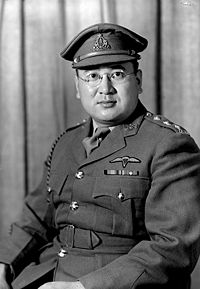Cheng, Roger K
|
| Roger Kee Cheng | |
|---|---|
| Born 16 May 1915 | |
 | |
| Allegiance | Canada |
| Service/branch | Royal Canadian Corps of Signals |
| Rank | Captain |
Roger Kee Cheng served as a member of the Royal Canadian Corps of Signals during the Second World War. He saw service in Ottawa prior to undertaking commando and guerrilla training for his subsequent service in the Molucca Islands and Borneo.
Early Life
Roger Cheng of Lillooet British Columbia was living in Vancouver before he joined the military. He graduated from McGill University Engineering School in 1938 with a degree in Electrical Engineering.
Military Service
After completing Signals training at A-7 Canadian Signal Training Centre Lieutenant Cheng was taken on strength of Canadian Signals Experimentation Establishment (CSEE) on 11 August 1942.
He disembarked in Australia on 22 November 1944 where he served with Services Reconnaissance Department (British Military Establishment No. 100) British Security Coordination until 31 October 1945. During this time he was employed on special operational duties in the Molucca Islands and Borneo from 13 July to 24 October 1945.
On 8 December 1945 Captain Cheng embarked at Brisbane Australia on board SS "English Prince" for return to Canada (Unattached List, NDHQ)[1]
Notes
In the portrait shown of Captain Cheng he is wearing parachute wings from the 3rd Royal Australian Regiment. He presumably wore these in preference to Canadian wings as he earned them, "having qualified by completing sufficient descents to be deemed as operationally trained"[2] while serving in the South Pacific.
Blog Post[3]
Born on 16 May 1915 Roger Kee Cheng went on to graduate as an electrical engineer from McGill University in 1938, be commissioned as the first Chinese-Canadian officer in the Royal Canadian Corps of Signals in 1941, and serve in Borneo as a member of the Services Reconnaissance Department (SRD) component of the Special Operations Executive (SOE) in 1945.
Second-Lieutenant Cheng began his officer training on 3 October 1941, probably at the Officer Training Centre in Brockville, Ontario. He was promoted Lieutenant (Lt) on 23 May, 1942, and completed his officer training at the Canadian Signal Training Centre in Kingston, Ontario, on 10 August, 1942.
Lt Cheng was then posted to the Canadian Signals Experimental Establishment (CSEE) in Ottawa, and promptly attached to the Royal Canadian Ordnance Corps (RCOC), and seconded to the Master General of Ordnance (MGO) Branch of the Director of Electrical and Communications Design (DECD). On 1 October, 1943 he was made an Acting Captain. On 27 May 1944, he ceased his attachment and secondment, and was taken on strength of No. 11 District Depot in British Columbia.
From 28 May until 26 August, 1944, at which time he started five days embarkation leave, it is probable that Lt Cheng, was a member of an original group of Chinese-Canadians who became known as the Kendall Group, and underwent special training in British Columbia's Okanagan Valley.
On 3 September, 1944, having finished his embarkation leave, Lt Cheng was promoted Captain, and posted to the "Q List", signifying that he was now officially on loan to the British forces. While details of his activities between then and 6 August, 1945, are sketchy, indications are that he, and five other Chinese-Canadians were landed, on that date, in Sarawk, in northern Borneo, by Catalina Flying Boat Upon arrival, the group joined a small British team which was gathering information on the movements of the Japanese as well as about conditions in prison camps in Kuching, the capital of Sarawak, where about 25,000 British prisoners of war were being held. The day after the team landed, the Americans dropped the atomic bomb on Hiroshima. Although Japan surrendered, many isolated Japanese units refused to accept defeat and the war dragged on for months. The team's major accomplishment was assisting in transferring many emaciated prisoners to Australia before returning home themselves.
On 31 October, 1945, Capt Cheng was attached for all purposes from the SRD to. No 1 Canadian Special Wireless Group, a signals intelligence organization that had arrived in McMillan's Road Camp, Darwin, Australia on 18 April, 1945. He returned to Canada on 5 January, 1946, at which time he was again taken on the strength of No. 11 Disrtict Depot. On 7 March, 1946, Roger Kee Cheng was discharged from the Canadian Army.
Related Pages
Related Items
References
- ↑ 1 Canadian Special Wireless Group - Part II Orders - 9 Jan 46
- ↑ 1 Canadian Special Wireless Group - Part II Orders - 26 Nov 45
- ↑ http://semaphoretosatellite.blogspot.ca/2011/10/captain-rk-cheng.html
